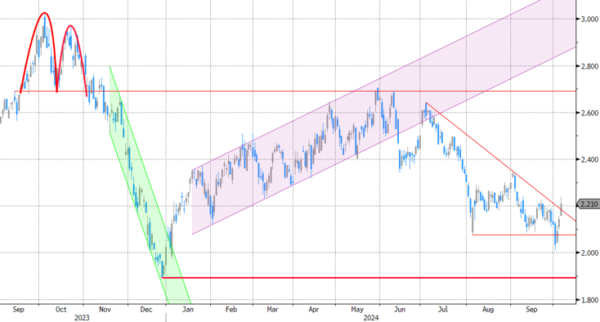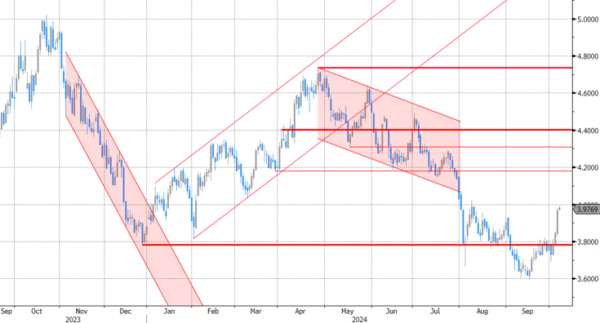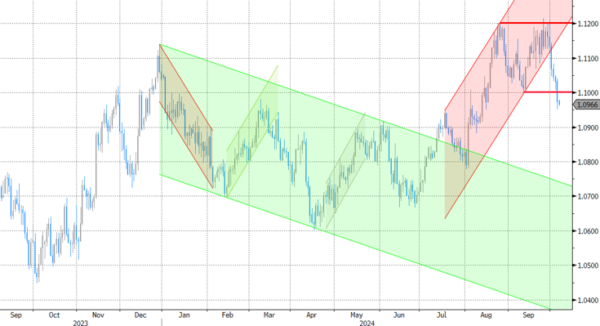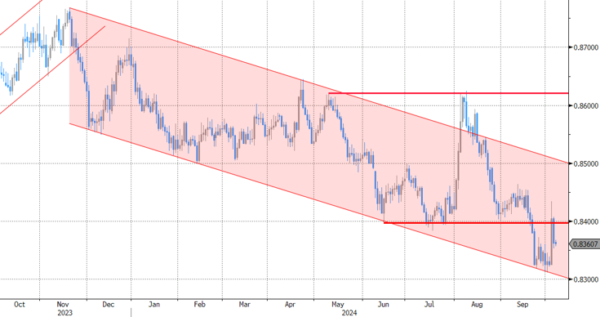Markets
The US September payrolls report beat market expectations for all key metrics. It also made markets question the need for ‘aggressive’ Fed-support to prevent a potential unwarranted softening of the labour market. US job growth in September reaccelerated from 159k to 254k and the figure for the previous two months was upwardly revised by 72k. The data of the consumer survey this time fully confirmed the payrolls’ data. The unemployment rate declined from 4.2% to 4.1% as job growth outpaced the a further rise in the labour force. Wage growth also printed at an higher than expected 0.4% M/M and 4.0% Y/Y. The market repositioning was impressive. US yields jumped between 21.6 bps (2-y) and 7.2 bps 30-y, with the move mainly driven by a rise in real yields (US 10-y +9.5 bps at 1.74%). The recent steepening trend also faced a hard roadblock. Money markets now discount a scenario of 25 bps steps at each of the four upcoming Fed meetings, at best. The trough of the cycle now is again seen near 3.25% rather than near 3.0%. EMU yields rose in sympathy even as the ECB is likely to step up the pace of easing with an ‘intermediate ‘ step later this month. German yields added between 12.2 bps (2-y) and 2.9 bps (30-y). ECB’s Villeroy in an interview this weekend said that a rate cut this month is quite probable as the ECB must watch the risk of inflation … undershooting the target! The rise in US (real) yields, this time didn’t hurt US equities as markets for now embrace the hypothesis of a no-landing scenario for the US economy, with solid growth supporting corporate earnings. US indices added between 0.81% (Dow) and 1.22% (Nasdaq). Of late, the dollar showed tentative signs of bottoming, but gains often were unconvincing. However, the payrolls in this respect also proved to be a gamechanger, improving the technical picture for the greenback. DXY now easily trades above 101.91 ST top (102.55). EUR/USD dropped below the 1.1002 neckline (close 1.0974). USD/JPY jumped from the 147 area to close at 148.7.
Asian markets this morning stay in risk-on modus. US yields tentatively drift further north. The dollar holds Friday’s gains. Today’s eco calendar is thin. Later this week, the US September CPI inflation will be published on Thursday. Markets will also keep an eye on how Fed governors assess the strong payrolls report. The US Treasury will sell 3-y, 10-y and 30-y notes at a regular auction series. From a market point of view, the burden of prove again shifted. Short-term, data will have to be unexpectedly weak, for markets to reconsider bets on faster easing. If not, the risk is for yields and the dollar to drift higher. For the US 2-y yield (currently 3.95%) 4.12% is a first ST target. EUR/USD is developing a double top pattern. The break of the 1.1002 neckline suggests a return to targets near 1.08.
News & Views
The US Committee for a Responsible Federal Budget calculated that US president-candidate Trump’s promises of tax cuts, tariff increases, military expansion and mass deportations would widen budget deficits by an estimated $7.5tn over the next decade. That’s on top of the $22tn deficits the US would run if Congress wouldn’t change current policies. Democratic-nominee and current vice-president Harris’ plans would increase deficits by $3.5tn over the same time horizon. The US debt ratio (currently 99% of GDP) is set to rise to 125% by 2035 if there are no changes to current laws, to 133% under Harris’ proposals and to 142% if Trump manages to implement his full policy agenda. The CRFB warns that the large and growing national debt threatens to slow economic growth, boost interest rates and payments, weaken national security, constrain policy choices and increase the risk of an eventual financial crisis.
The KMPGB and REC, UK report on jobs pointed at a further reduction in permanent placements during September, extending the current run of contraction to two years. Temp billings were also lowered for a third successive month. Uncertainty in the outlook, including around government policy ahead of late October’s Budget, meant companies were cautious in their hiring activity. REC chief executive Carberry said that recruiters report that projects in client businesses are ready to go, but that confidence is not yet high enough to push the button. Latest data showed the weakest rise in salaries for over three-and-a-half years. A greater number of candidates and reduced demand helped to limit pay growth.
Graphs
GE 10y yield
The ECB cut policy rates by 25 bps in June and in September. Stubborn inflation (core, services) still is a source of concern, but very weak PMI’s and soft comments of Lagarde (and other MPC members) suggest the ECB is likely to step up the pace of easing with an October cut. Spill-overs from strong US data prevented a test of the 2.0% barrier. 2.00-2.35% might serve as a ST consolidation range.
US 10-y yield
The Fed kicked off its easing cycle with a 50 bps move. The Fed shifting focus from inflation to a potential slowdown in growth/employment made markets consider more 50 bps steps. Strong US September payrolls suggest the economy doesn’t need aggressive Fed support for now, but the debate might resurface as the economic cycle develops. For the US 10-y, 3.60% serves as strong support. The steepening trend is taking a breather.
EUR/USD
EUR/USD moved above the 1.09 resistance area and twice tested the 1.12 big figure as the dollar lost interest rate support at stealth pace. Bets on fast and large rate cuts trumped traditional safe haven flows into USD. An ailing euro(pean economy) partially offset some of the general USD weakness. After solid early October US data, the dollar regained traction, with EUR/USD breaking the 1.1002 neckline. Targets of this pattern are near 1.08.
EUR/GBP
The BoE delivered a hawkish cut in August. Policy restrictiveness was indicated to be further unwound gradually. The economic picture between the UK and Europe also was increasingly diverging to the benefit of sterling, pulling EUR/GBP below 0.84 support. Dovish comments by BoE Bailey ended by default GBP-strength.

















